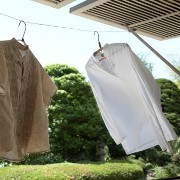 Photo: Getty Images
Photo: Getty Images
You may be surprised to know that the finish on wrinkle-free clothing comes from a resin that releases formaldehyde. In fact, many household products that resist wrinkling such as sheets and pillowcases, drapes and the upholstery on your couch contain this resin.
Formaldehyde is the same chemical that is used in embalming fluid and while overall, exposure to it is unlikely to cause ill effects, there is the potential that skin contact with wrinkle-free clothing can cause contact dermatitis. Contact dermatitis causes an itchy skin rash that may also include blisters.
Many products produced have limited to no regulation of the chemicals they may contain. “The United States does not regulate formaldehyde levels in clothing, most of which is now made overseas. Nor does any government agency require manufacturers to disclose the use of chemicals on labels,” according the New York Times.
Formaldehyde allergies are not common. However, formaldehyde is present in many of the products used today from cosmetics and furniture to household cleaners. Those who are additionally exposed to formaldehyde through their work carry the greatest risk of developing sensitivities. Over the last several years, formaldehyde levels have diminished in the workplace due to workplace regulations put in place to protect workers from inhaling it and through improvements in the types of resins that have been developed.
A recent study by the Government Accountability Office tested 180 household items to determine if they met the stringent voluntary standards that are used in Japan. About 5.5 percent of items, “primarily wrinkle-free shirts and pants, easy-care pillow cases, crib sheets and a boy’s baseball hat exceeded the standard of 75 parts per a million, for products that touch the skin.”
No specific recommendations were made by the GAO but it did surprise the researchers that the levels were elevated, particularly in men’s no iron shirts. John Stephenson, an environmental director at the GAO, indicated to the New York Times that it gave him pause for thought since he wears no iron shirts exclusively. Since learning the results he now washes them at least twice before wearing them.
What you should do to reduce formaldehyde exposure?
Always wash newly-purchased wrinkle-free items before wearing or sleeping on them. You may want to rewash them more than once to be careful.
Fabrics made out of 100 percent cotton, polyester, nylon or acrylic have the lowest amount of formaldehyde levels so they are the best choices for those with sensitive skin.
If you find you are developing rashes after wearing wrinkle free clothes, first try changing your detergent. If no improvement, consider seeing a dermatologist to have a formaldehyde skin patch test.
If you have sensitive skin, consider avoiding wrinkle-free clothing entirely. Ironing your clothes may seem like a throw back practice but sometimes doing things the old fashioned way is the safest path to follow.
sources:
www.nytimes.com/2010/12/11/your-money/11wrinkle.html?_r=1
http://dermnetnz.org/dermatitis/formaldehyde-allergy.html
Michele is an R.N. freelance writer with a special interest in woman’s healthcare and quality of care issues. Other articles by Michele are at www.helium.com/users/487540/show_articles





Add a CommentComments
There are no comments yet. Be the first one and get the conversation started!